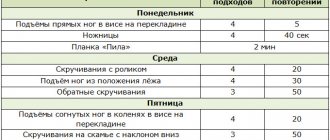Is the effectiveness of cardio for weight loss overrated?
There have been changes over the past couple of years. Recently, it has become a popular claim that cardio is a waste of time, negatively affects weight loss and does not burn fat.
This is wrong. Cardio training is distinguished from strength training by its accessibility, i.e. you don't need any additional equipment, you can practice at home. During cardio, calories are burned more efficiently, making it easy to create a calorie deficit.
During isolated strength training you can burn about 200 kcal/hour, and during cardio twice as much. Even when you start to factor in the afterburn effect of strength training, cardio still reigns supreme.
An important point: it is necessary to perform workouts at a moderate or fast pace 3 times a week or more. Choose an option that will bring you pleasure and practice.
Benefits of Cardio
Cardio not only burns calories well, but also has a number of other benefits:
- Increasing your fitness level - You will improve your cardiovascular function, which will lead to a healthy heart, increase your maximum oxygen uptake, improve gas exchange rates in your lungs and tissues, and lower your resting heart rate.
- Better Athletic Performance - Almost all athletic trainers use cardio as a base for their athletes. This helps them maintain high levels of stamina and endurance to perform during strength and anaerobic training. In addition, they restore muscles well after exercise.
- You'll be healthier - cardio improves lipid and blood sugar levels, as well as joint, muscle and bone health, and reduces the risk of metabolic and cardiovascular diseases. This means you are less likely to suffer from coronary heart disease, diabetes or low bone density, and even reduce your risk of developing certain types of cancer.
Nutrition during cardio training
There are a number of recommendations for creating a diet to achieve the best results in the process of getting rid of unwanted weight:
- It is necessary to calculate the basal metabolism (the number of calories consumed by the body at rest), which is then multiplied by the activity coefficient to determine the average level of energy expenditure per day (a detailed algorithm can be found on the Internet). The resulting figure is the number of calories that will maintain a person’s existing weight unchanged. To lose weight, you need to subtract 100-200 calories from the final value . The diet is prepared in accordance with the calculated calorie content.
Photo 2. Table showing approximate calorie consumption during various types of workouts.
- Limit or exclude consumption of: foods fried in oil (for example, fried potatoes, fatty cutlets, etc.);
- excessively salty foods (sausages, smoked meats, snacks, etc.);
- simple carbohydrates (cakes, sweets, chocolate, baked goods made from premium flour, etc.).
How often should you do cardio?
Let's make something clear from the beginning. Cardio will not be bad for you. Does it burn calories as well as during strength training? No. Even better.
Don't get us wrong. Strength training burns a huge amount of calories, but based on metabolic test results, cardio is still the best option for fat loss.
Cardio is your best choice for a workout that burns fat, improves health and well-being, and increases your fitness level.
Find out which cardio workouts are most effective for weight loss.
The physiological processes of weight loss and fat oxidation need to be addressed. Without understanding how energy works, you will only wear out your shoes and not lose an ounce.
Strength programs
Strength training is a great way to lose weight, despite the fact that most people associate it with gaining muscle. At the same time, it is advisable to combine them with cardio exercises - this way the effect in terms of weight loss will be maximum.
Strength physical exercises during “drying” solve the following problems:
- Preservation and increase of muscle mass;
- Increased energy consumption.
The training process should be built around basic heavy movements. By “heavy” movements we mean sets using 70-85% of the maximum weight. Weighting allows you to burn fat and build muscle at the same time. Heavy lifting weights speeds up metabolism 3 days in advance, which is why such workouts are considered the most effective.
Basic strength exercises are multi-joint movements such as presses (standing, lying), squats, deadlifts. Exercises that use large muscles use more energy during and immediately after exercise than exercises that target smaller muscles.
Be sure to read: How to walk up stairs correctly to lose weight?
Energy balance is the key to success
The secret of the industry is that no one wants you to know that if you create a calorie deficit, that is, you eat less than you burn, then you will lose weight... and if you create a surplus, you will gain weight.
When you consume too many high-calorie foods, your body stores energy in fat cells in preparation for starvation. This is called a calorie surplus or positive energy balance.
The problem is that the hunger strike will never happen and you will continue to accumulate more and more. And this is definitely bad.
On the other hand, if you eat fewer calories than you burn, you will be given the master key to your fat cells, opening them up and unlocking that extra energy to make up the difference.
This is called a calorie deficit or negative energy balance. And this is the key to fat loss.
How to achieve a calorie deficit?
There are two ways to achieve a negative energy balance: reducing your calorie intake and exercising. During cardio, calories are burned and hence can be subtracted from your total intake.
The methods have their pros and cons.
Let's say that in order to make up for the deficiency, you need to subtract 500 kcal from your daily requirement. You can do this by skipping a 500-calorie meal or eating and then exercising to burn off the excess.
Before you decide how much cardio you need to do to lose weight, it's important to understand the basics of how your body functions.
“500g of fat contains 3500 kcal and therefore you need to burn 3500 kcal to lose 500g per week.”
Here's what you should do in terms of workouts per week. If you want to burn 3500 kcal per week, there are 3 options:
- Do 30 minutes of cardio per day and eat a moderate calorie diet: If you're not active, you won't be able to eat much food until you reach a calorie surplus. But you don't have to exercise to achieve a calorie deficit, suitable for those who don't like to exercise - but you may be very hungry.
- Do cardio 5 days a week and lightly restrict your calories: the more you exercise, the more you can eat, and by staying in a calorie deficit, you can eat more each day. You will become healthier and slimmer.
- Do cardio 1 to 3 days a week for 30 minutes and stick to a moderate calorie diet: eat less and exercise more. You can lose weight even faster by exercising on an empty stomach, but you run the risk of getting sick if you do long-term cardio workouts and consume few calories.
The third option may appeal to you, but this option becomes overwhelming very quickly.
Important Point: The key to losing weight is achieving a calorie deficit by cutting food intake or burning it through exercise, or a combination of the two to increase results.
First week
At first it was not entirely clear where to integrate the training. In fact, you need to carve out not half an hour, but an hour or so for the active part, stretching and shower. I have a flexible schedule, so I experimented: I studied in the morning, in the middle of the day and in the evening.
It was more pleasant to train in the first half of the day: after the load, the body becomes more active, and the desire to create, work or engage in other activities appears. At about nine o'clock in the evening, this state of mind is a little inappropriate, although pleasant. In addition, it was difficult for me to fall asleep at the usual time if I trained late. In general, if you get up early in the morning and it is important to go to bed on time, I do not recommend dancing or running after 19:00.
As for the training itself, I really liked dancing - it’s fun, interesting, you don’t notice how time passes while you’re learning the movements. But, to be honest, for the last 10 minutes it was already difficult to remember the sequences, the enthusiasm waned somewhat and I just wanted to run or do jumping jacks. As a person with virtually no dance experience, not only my body, but also my brain was tired: the coach does not show the movements slowly, you need to think and remember quickly, in the process. But I think those who have done at least a little dancing will not have such problems. Overall, I'm happy - I'm just training my weak points. My heart rate in the middle of the workout was plus or minus 135 beats per minute, that is, it was right in the middle of the range I needed.
Recommendations from experts
Here are some basic tips for losing weight. Consult with a qualified nutritionist or certified fitness trainer to come up with a workout plan that fits your goals and schedule.
When it comes to recommendations, there is no better place than the American College of Sports Medicine.
Why? A close-knit group of expert physiologists, sports scientists and medical personnel know what they are talking about. And they are responsible for conducting all the research on a topic related to health and fitness, and for providing educational and practical guidance that will help you achieve your goals.
The college's recommendations are as follows:
- 150 minutes of exercise per week at an average pace;
- 5 days a week for 30-60 minutes (moderate) or 3 days a week for 20-60 minutes (vigorous);
- Work at an intensity between 55% and 95% of your maximum heart rate.
Choose any exercise you enjoy - running, swimming, cycling - and gradually increase the duration and intensity.
Likewise, Mahri Relin, a certified personal trainer, said she encourages her clients to do four to five cardio workouts per week, each lasting 30 to 45 minutes.
Celebrity fitness trainer Katherine Greiner recommends 30 to 45 minutes of cardio per day or 20 minutes of high-intensity interval training (HIIT).
It's important not to overdo it. Relin stated, “Strong cardio workouts can cause extreme hunger, and the calories burned are replenished, if not exceeded.”
"Too many repetitions of cardio can lead to what's called 'adrenaline fatigue,' which can lead to weight gain," Greiner added.
Follow your weight loss plan
If your goal is permanent fat loss, then you need to burn enough calories to get results. As mentioned earlier, to lose 500g per week, you need to create a deficit of 3500 kcal, in other words you need to burn 3500 more than you ate. A 30-minute workout on a flat surface will burn about 120 calories. Thus, to burn 1 kg by walking, you need to walk 2 hours a day.
Don't worry. Nobody forces you to exercise 2 hours every day. The best way to lose weight is to create a calorie deficit through exercise and reducing your calorie intake.
For example, over the course of a week you can reduce the calorie content of your food by 250 kcal by replacing mayonnaise with mustard and fruit yogurt with light yogurt. In addition, you can burn an additional 250 per day with an hour of walking or half an hour of jogging.
Cardio training is one of the components of losing weight. You need to change your eating habits correctly and follow an exercise program.
Increase weight loss
Work in your target heart rate zone most of the time to lose weight. Remember: if you're "out of shape," as people like to say, even training at 50 percent of your maximum heart rate can help improve your fitness level.
You may have heard that slow-paced workouts are more effective for weight loss than intense-paced workouts. In fact, many of the cardio machines at your gym are programmed to "burn fat" and keep you at a slow pace. But this is misleading. It turns out that the concept of a fat-burning zone is no more real than the twilight zone.
During low-intensity aerobic exercise, the body converts fat into its main energy resource.
As you approach the critical point, the body begins to use a lower percentage of fat and a higher percentage of carbohydrates, another source of energy. However, Raising the Pace allows you to burn not only more calories from fat, but even more calories in total.
So, if you roller skate at a slow pace for 30 minutes, you can burn about 100 calories - about 80 percent of them from fat (that is, 80 kcal). But if you ride the same amount on hilly terrain, you can burn 300 kcal - 30 percent of it from fat (that's 90 kcal).
So at a fast pace you burn twice as many calories and 10 more calories of fat.
Of course, fast-paced, high-difficulty workouts aren't always better. If you're just starting out, you probably won't be able to handle training at a faster pace without regretting it. If you train at a slower pace, you'll be able to do a lot more cardio, so you'll end up burning more calories and fat.
Exercises that help you burn more calories
"Increase your workout productivity and burn 1,000 calories per hour." These types of advertisements can be seen on treadmills, stair machines, and other exercise equipment. And it is true. You can burn 1000 kcal/hour doing exercises on these machines if the machine is set to maximum and you have bionic legs.
If you are a beginner, you will hold on for about 30 seconds at this pace and burn 8.3 calories, after which the paramedics will take your weakened body away on a stretcher.
There is no better approach than this: choose an activity that you can do for a long period of time, say 10-15 minutes. Of course, running burns more calories than walking, but if running wears you out after a few meters or your knees start to hurt, then it's better to walk.
The following table shows how many calories you can burn by doing popular exercises. The number of calories depends on the intensity of the workout, weight, muscle mass and metabolism.
In general, beginners can burn 4 to 5 calories per minute of exercise, while a person in excellent shape can burn 10 to 12 calories per minute.
The table shows games such as basketball and volleyball. Exercises like these aren't strictly aerobic, but they can give you a great workout and promote well-being and weight loss.
These numbers refer to people weighing 68 kg. (If you weigh less, you'll burn a little less; if you weigh more, you'll burn a little more.
| Number of calories burned | ||||
| Exercise | 15 minutes | 30 min | 45 min | 60 min |
| Aerobic dancing | 171 | 342 | 513 | 684 |
| Basketball | 141 | 282 | 432 | 564 |
| Bicycle 20 km/x | 142 | 283 | 425 | 566 |
| Bicycle 25 km/h | 177 | 354 | 531 | 708 |
| Bicycle 29 km/h | 213 | 425 | 638 | 850 |
| Boxing | 165 | 330 | 495 | 660 |
| Circuit strength training | 189 | 378 | 576 | 756 |
| Cross country skiing | 146 | 291 | 437 | 583 |
| Skiing | 105 | 210 | 315 | 420 |
| Golf | 87 | 174 | 261 | 348 |
| Rollers | 150 | 300 | 450 | 600 |
| Jumping rope, 60-80 jumps per minute | 143 | 286 | 429 | 572 |
| Karate, taekwon-do | 180 | 360 | 540 | 720 |
| Kayaking | 75 | 150 | 225 | 300 |
| Racquetball | 114 | 228 | 342 | 456 |
| Rowing machine | 104 | 208 | 310 | 415 |
| Running 16 km/h | 183 | 365 | 548 | 731 |
| Running 13 km/h | 223 | 446 | 670 | 893 |
| Ski simulator | 141 | 282 | 423 | 564 |
| Rowing | 152 | 304 | 456 | 608 |
| Freestyle swimming, 32 meters/min | 124 | 248 | 371 | 497 |
| Freestyle swimming, 45 meters/min | 131 | 261 | 392 | 523 |
| Singles tennis | 116 | 232 | 348 | 464 |
| Tennis "doubles" | 43 | 85 | 128 | 170 |
| Climber training | 188 | 375 | 563 | 750 |
| Walking on flat terrain, 32 km | 60 | 120 | 180 | 240 |
| Hilly walking, 32 km | 81 | 162 | 243 | 324 |
| Walking on flat terrain, 25 km | 73 | 146 | 219 | 292 |
| Hilly walking, 25 km | 102 | 206 | 279 | 412 |
| Water aerobics | 70 | 140 | 210 | 280 |
Cardio and weight loss
Swimming, jogging in the morning, cycling and other cardio exercises are good for the body, but they do not help burn fat. Moreover, you may even gain weight compared to before cutting. Cardio does not burn very many calories - yes, you move, and that's great, but not enough to lose weight. The second point is that the calories spent can be quickly replenished - a jar of yogurt, a red apple, and in terms of energy intake and expenditure, you can assume that you did not run at all for 20 minutes.
Be sure to read: The best static exercises for weight loss
Third, the body gets used to cardio exercise and begins to expend less energy. That is, at first, a half-hour jog in the morning was enough for you to lose 2-3 kg, and then you will have to do much more.
Fitness trainers don't recommend doing a lot of cardio if you're actively cutting to avoid losing muscle and causing your metabolism to slow down. It is enough to train just enough so that fat does not stop burning.










